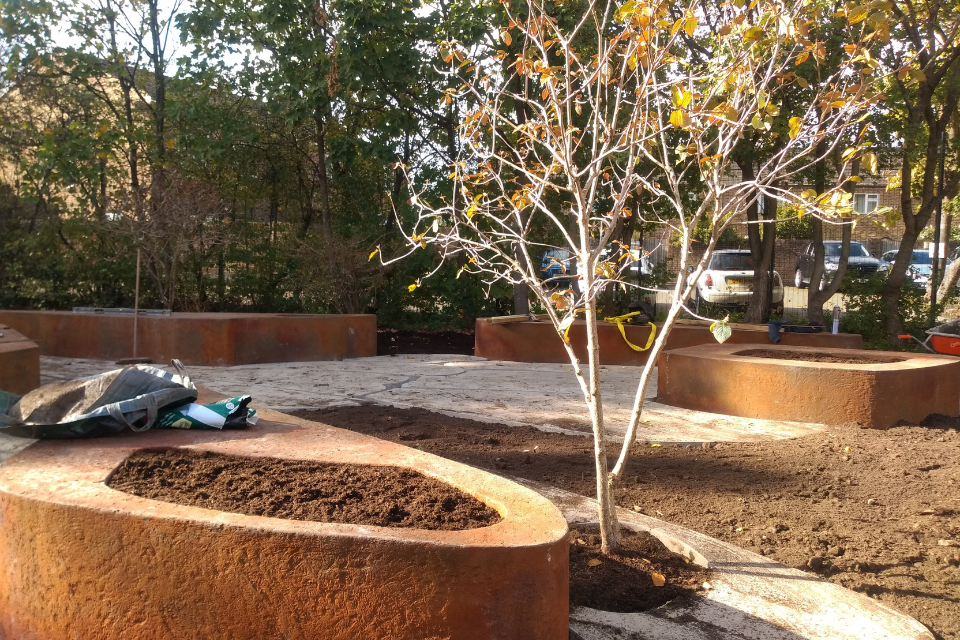December in the Bee Garden
Find out which bees can be found in the UK, watch RHS Wildlife Expert Helen Bostock answer your questions and follow the installation of the RHS Bee Garden at a London school.
05 December 2022
.png)
A solitary bee
How many bees can be found in the UK?
Explore the meaning behind the words in bold in our glossary at the bottom of this page.
Did you know that there are many different types of bee buzzing around the UK? In fact there are over 270 different species. Some of these bees are solitary and like to live on their own, while others are social and like to live in groups.
Over 250 species are solitary bees, most of these are active during the spring and summer months but the ivy bee can be spotted well into autumn visiting ivy flowers to collect pollen. Some examples of solitary bees include red mason bees, wool carder bees and leaf-cutter bees.
Most bumblebees and the honeybee are social bees. Bumblebees are large and furry and make a deep buzzing sound when they fly, they can be black, red, orange, cream and yellow. There are 24 different types of bumblebee in the UK and most live in wild colonies.
There is only one species of honeybee in the UK. Honeybees mainly live in a hive where they are looked after by a beekeeper, most honeybees are not wild. Honeybees are smaller and less furry than bumblebees, they are mainly yellow and brown. Examples of bumblebee species include: tree bumblebees, white tailed bumblebees and red tailed bumblebees.
You can find out more about bees on our website and in the wild bee action pack on the Wild About Gardens website - scroll down to the bottom of the page to find booklets on other wildlife too including butterflies, hedgehogs and bats.
If you would like to find out what a pollinator is, visit our September in the Bee Garden webpage.
.png)
.png)
.png)
Left: Tree bumblebee, Right: Leaf-cutter bee (Image credit: Jean Vernon)
Your pollinator questions answered
In October we asked you to send us any questions that you had about bees and pollen. RHS Wildlife Expert Helen Bostock has the answers to some of your brilliant questions - watch this video to find out more:
Installation of the Bee Garden at St George’s Primary, Camberwell
It has been an exciting few weeks for the children, staff and families at St George’s Primary School in Camberwell, as the BBC Studios Our Green Planet and RHS Bee Garden, designed by Joe Swift for the 2022 RHS Chelsea Flower Show, has been installed. The next step will be the planting the space with plants that are perfect for pollinators.
Do you have a space in your school that bees love to visit? Let us know what attracts them to your space with the hashtag #RHSWinterBeeGarden.
Glossary
|
Beekeeper
|
A person who looks after honeybees.
|
|
Colonies
|
Large groups of one type of animal that are living and working together. Social bees lives in colonies, including honeybees and most bumblebees. Honeybee colonies are given the specific term ‘hive’ or ‘beehive’.
|
|
Hive
|
A structure where honeybees live and raise their young.
|
|
Ivy
|
A climbing evergreen plant that produces flowers in autumn.
|
|
Pollen
|
Dust-like powder produced by flowers and carried by wind or pollinators to other flowers of the same type, so they can make seeds and grow new plants.
|
|
Social
|
Lives with others. A social bee lives with other bees.
|
|
Solitary
|
Lives by themselves. A solitary bee is one that does not live in a colony with a queen and workers.
|
|
Species
|
Animals or plants that have similar features to each other. They are closely related enough that they can successfully breed with each other.
|